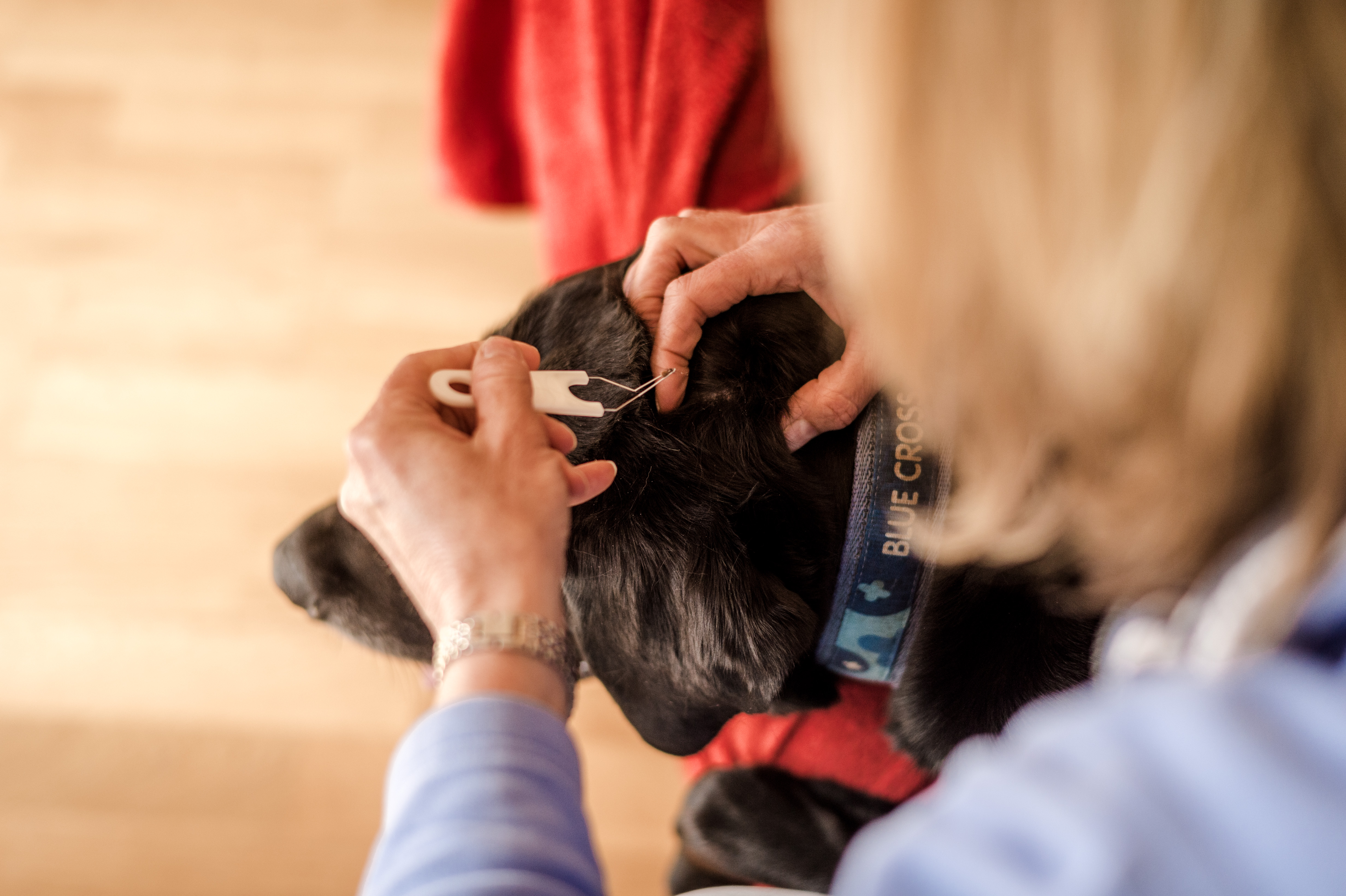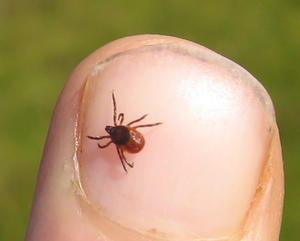
Ticks on dogs
Ticks are grey-brown egg-shaped, blood-sucking creepy crawlies.
They have six or eight legs (depending on life stage), making them look spider-like, and vary in size from about 1mm to 1cm long. Ticks can look small at first and get bigger and darker as they fill with blood.
How do I know if my dog has a tick?
After feeding, ticks are big enough to spot and feel like a small bump on your pet’s skin. Run your hands over your dog’s body when you get back from a walk to check for them. They tend to attach themselves to areas around a dog’s head, neck, ears and feet.
Ticks don’t fly or jump, but climb or drop on to your dog’s coat when they brush past them.
How to remove a tick from a dog
Twisting them off your dog is the best removal method, and pet shops sell handy tick-removal devices to make this easier.
You need to be careful not to squeeze the tick’s body, or allow its head to get stuck inside your dog. Squeezing a tick’s body can cause it to expel blood back into your dog, increasing the risk of infection. Ask your vet for advice if you're worried about doing this.
- Once you've located the tick, using gloves if you have them, gently part your dog's fur so that you can easily reach the tick
- Get your tick remover and slowly push it under the tick
- When you have a firm grasp of the tick, twist it in a clockwise direction several times until the tick comes loose
- Take a look at your dog's skin and make sure the tick is completely removed
- Get rid of the tick by putting it in alcohol or popping it in tissue and flushing it down the toilet before washing your hands
Important
Never use your fingers to crush a tick.
Ticks carry diseases, so it’s important to remove any that attach themselves to your dog as soon as possible.
How can I protect my dog from ticks?
If you live in an area with ticks, it’s a good idea to use a tick treatment that will either repel ticks or kill them quickly if they attach - the longer the tick is attached, the greater the risk of your dog catching a disease. Spot on treatments, tablets and collars are available and it’s best to consult your vet about which is most suitable for your pet.
Important
Read tick treatment instructions very carefully if you have a cat. Some dog treatments can be lethal if used on cats.
Why should I protect my dog against ticks?
Ticks are very good at passing on infections from one animal to another. They feed by biting an animal and feasting on their blood. Once they have had enough, they drop off.
Ticks transmit microbes that cause diseases, such as lyme disease and babesiosis.
Lyme disease in dogs
Lyme disease is a serious bacterial infection. So, if you walk your dog in areas with deer or sheep make sure you keep a close eye on your dog. If your dog has lyme disease, you may notice:
- loss of appetite
- depression
- a fever
- lameness
- swollen and painful joints
- swollen lymph nodes
These symptoms can be present in other conditions, so if you think your pet has lyme disease, contact your vet. They can perform tests to identify lyme disease and start treatment with antibiotics.
Babesiosis in dogs
Babesiosis is extremely rare in the UK and the tick that spreads it is currently only found in southern England and on the continent.
It takes around two weeks to show signs and symptoms of the disease, but some pets are not diagnosed for months or years after transmission.
If your dog is suffering from babesiosis, symptoms in dogs include:
- pale gums
- a swollen abdomen
- a fever
- loss of appetite
- they become depressed
- their skin becomes yellowish
Tick-borne encephalitis in dogs
Tick-borne encephalitis can be found is some species of tick in the UK. It is extremely rare in dogs. Symptoms of tick-borne encephalitis in dogs include:
- a high temperature or fever
- loss of appetite
- weakness and fatigue
- seizures
- dizziness, drowsiness and loss of consciousness
Important
If you spot any symptoms after walking your dog in a tick-infested area, contact your vet and make sure to tell them your dog may have been bitten by a tick. These symptoms can be caused by other conditions, but your vet will be able to identify the cause.
Where are ticks found?
Ticks are common in woodland, grassland and heath areas, but can also be found in your garden if you live in an area with lots of wildlife. You are most likely to come across them in areas with lots of deer or sheep between spring and autumn. But they are active throughout the year.
Tick prevention on holiday
If you're planning on taking your dog abroad, be sure to speak with your vet before you go. Ticks in other countries can pass on different diseases and it's important that your dog is protected against these.
How can I avoid being bitten by a tick?
Owners are more likely to be bitten by ticks if they walk their dogs in areas with a high tick population. Hikers and people who exercise in woodland and the countryside are at risk too.
Three ways to help avoid tick bites
- Wear long sleeved tops when out walking and either tuck trousers into socks, or wear long socks
- Check your clothes for ticks and brush them off quickly if you spot any
- Use an insect repellent
How can I remove a tick from my body?
Twisting them off your body is the best removal method. You can use a pair of tweezers or a tick removal tool. After you’ve removed the tick, give the bite area a good wash.
Ticks should be removed from your body as quickly as possible. Be very careful not to squeeze the tick’s body, or allow its head to get stuck inside your body. Squeezing a tick’s body increases the risk of infection.
Important
Never try to burn off the tick or smother it with lotions, oils or moisturisers. This may cause the tick to expel some of the blood back into you, putting you at higher risk of infection.
If you develop a rash around the tick bite – these often look like red rings around the bite area – or feel unwell, contact your doctor and make sure to tell them you have been bitten by a tick. The earlier you seek treatment from your doctor, the better.
Can I catch a disease from a tick?
People can catch lyme disease from ticks, just like dogs.
Lyme disease is serious. So, if you walk your dog in areas with deer or sheep make sure you take precautions to avoid being bitten.
Symptoms of lyme disease include:
- a circular rash
- muscle and joint pain
- fatigue
Left untreated, the disease can develop into conditions such as:
- viral-like meningitis
- facial palsy
- arthritis
- nerve damage
Lyme disease can be treated with antibiotics if caught early enough, so inform your doctor if you have been bitten by a tick.
Note
People can also catch babesiosis and encephalitis from ticks although it's extremely rare. Symptoms can include a high fever with headache, neck stiffness, loss of appetite, tiredness, confusion or reduced consciousness. If you feel unwell after being bitten by a tick, you should follow the NHS’s advice.
Page details
Reviewed
• 3 May 2023
Next review
• 2 May 2026

Donate today
We can’t provide pet advice without your support. Your donations allow our experts to create advice that is accurate and up to date. If you found this page useful, please help us to create more pet advice by donating.

Donate today
We can’t provide pet advice without your support. Your donations allow our experts to create advice that is accurate and up to date. If you found this page useful, please help us to create more pet advice by donating.







